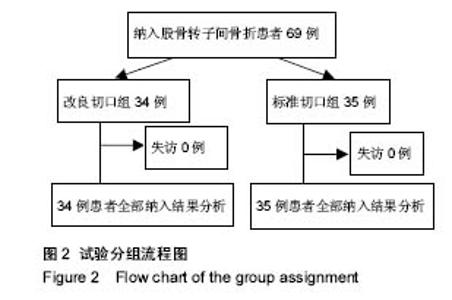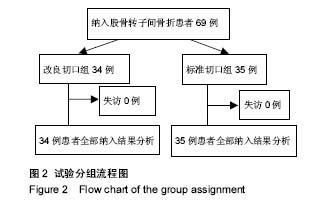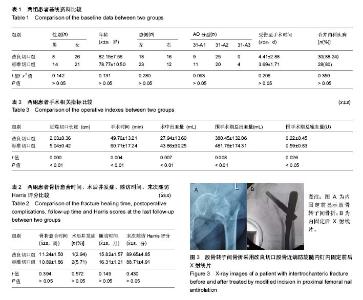| [1] Makridis KG, Karachalios T, Kontogeorgakos VA, et al. The effect of osteoporotic treatment on the functional outcome, re-fracture rate, quality of life and mortality in patients with hip fractures: a prospective functional and clinical outcome study on 520 patients. Injury.2015;46(2): 378-383.[2] Kim SR, Park YG, Kang SY, et al. Undertreatment of osteoporosis following hip fractures in jeju cohort study. J Bone Metab.2014;21(4): 263-268.[3] 赵洪普,徐秋玉,吕玉明,等. 三种内固定方法(PFNA、LPFP、DHS)治疗老年股骨粗隆间骨折的比较[J]. 中国骨与关节损伤杂志, 2012, 27(6): 500-502.[4] Kammerlander C, Doshi H, Gebhard F, et al. Long-term results of the augmented PFNA: a prospective multicenter trial. Arch Orthop Trauma Surg.2014;134(3): 343-349.[5] Yu W, Zhang X, Zhu X, et al. Proximal femoral nails anti-rotation versus dynamic hip screws for treatment of stable intertrochanteric femur fractures: an outcome analyses with a minimum 4 years of follow-up. BMC Musculoskelet Disord.2016;17(1): 222-225.[6] Sahin EK, Imerci A, K?n?k H, et al. Comparison of proximal femoral nail antirotation (PFNA) with AO dynamic condylar screws (DCS) for the treatment for unstable peritrochanteric femoral fractures. Eur J Orthop Surg Traumatol.2014;24(3): 347-352.[7] Kokoroghiannis C, Aktselis I, Deligeorgis A, et al. Evolving concepts of stability and intramedullary fixation of intertrochanteric fractures-a review. Injury. 2013;44(6):877-878.[8] Shen J, Hu C, Yu S, et al. A meta-analysis of percutenous compression plate versus intramedullary nail for treatment of intertrochanteric HIP fractures. Int J Surg.2016;5(29): 151-158.[9] Lu, J, Chen, YY, Zhang, L, et, al. Laboratory nutritional parameters predict one-year mortality in elderly patients with intertrochanteric fracture. Asia Pac J Clin Nutr.2016;25(3): 457-463[10] Tan BY, Lau AC, Kwek EB. Morphology and fixation pitfalls of a highly unstable intertrochanteric fracture variant.J Orthop Surg (Hong Kong).2015;23(2): 142-145.[11] Swart E, Makhni EC, Macaulay W, et al. Cost-effectiveness analysis of fixation options for intertrochanteric hip fractures. J Bone Joint Surg Am. 2014;96(19):1612-1620.[12] Joshi D, Dhamangaonkar AC, Ramawat S, et al. Predictors of iatrogenic lateral wall fractures while treating intertrochanteric fracture femur with the dynamic hip screw system in Indian patients.Eur J Orthop Surg Traumatol. 2015;25(4): 677-682.[13] Huang Y, Zhang C, Luo Y. A comparative biomechanical study of proximal femoral nail (InterTAN) and proximal femoral nail antirotation for intertrochanteric fractures. Int Orthop. 2013; 37(12):2465-2473. [14] 王海洲,林强,陈海云,等. InterTan髓内钉治疗股骨转子间骨折的疗效分析[J].中华创伤骨科杂志,2012,14(8):729-731.[15] 杨飞,韩启明,杨凤明,等. 老年股骨粗隆间骨折微创InterTan髓内钉与PFNA-Ⅱ髓内钉临床疗效分析[J]. 中国矫形外科杂志, 2015, 23(10): 897-901.[16] Zhang S, Zhang K, Jia Y, et,al. InterTan nail versus Proximal Femoral Nail Antirotation-Asia in the treatment of unstable trochanteric fractures. Orthopedics. 2013;36(3):e288-94. [17] 袁晓明,姚琦,倪杰,等. 股骨近端防旋髓内钉与动力髋螺钉治疗老年股骨粗隆间骨折的荟萃分析[J].中华医学杂志,2014,94(11):836-839.[18] 赵洪普,徐秋玉,吕玉明,等. 三种内固定方法(PFNA、LPFP、DHS)治疗老年股骨粗隆间骨折的比较[J]. 中国骨与关节损伤杂志, 2012, 27(6): 500-502.[19] 余作取,许兵,戴寿旺,等. 股骨外侧壁在股骨粗隆间骨折内固定中的生物力学研究[J]. 浙江创伤外科, 2015, 20(6): 1055-1058.[20] Zeng C,Wang YR,Wei J,et al.Treatment of trochanteric fractures with proximal femoral nail antirotation or dynamic hip screw systems: a meta-analysis. J Int Med Res. 2012;40(3): 839-851.[21] Zeng C, Wang Y, Wei J,et al.Meta-analysis of proximal femoral nail anti-rotation versus dynamic hip screw in the treatment of trochanteric fractures.Zhong Nan Da Xue Xue Bao Yi Xue Ban. 2012;37(6):606-615. [22] Zhou F, Zhang ZS, Yang H,et al.Less invasive stabilization system (LISS) versus proximal femoral nail anti-rotation (PFNA) in treating proximal femoral fractures: a prospective randomized study.J Orthop Trauma. 2012;26(3):155-162.[23] Yu W,Zhang X, Wu R, et al.The visible and hidden blood loss of Asia proximal femoral nail anti-rotation and dynamic hip screw in the treatment of intertrochanteric fractures of elderly high- risk patients: a retrospective comparative study with a minimum 3 years of follow-up.BMC Musculoskelet Disord. 2016;17:269.[24] Ma KL, Wang X, Luan FJ,et al.Proximal femoral nails antirotation, Gamma nails, and dynamic hip screws for fixation of intertrochanteric fractures of femur: A meta-analysis.Orthop Traumatol Surg Res.2014;100(8): 859-866. [25] Li YJ, Li ZB, Yu WH, et al.Case-control study on dynamic hip screw and proximal femoral nail anti-rotation for the treatment of unstable intertrochanteric fractures in elderly patients. Zhongguo Gu Shang.2013;26(12):977-980. [26] Yu W, Zhang X, Zhu X,et al.A retrospective analysis of the InterTan nail and proximal femoral nail anti-rotation-Asia in the treatment of unstable intertrochanteric femur fractures in the elderly.J Orthop Surg Res.2016;11:10.[27] 张逸,凌沈景,毛智,等.股骨粗隆间骨折内固定手术隐性失血的相关因素分析[J]. 中国修复重建外科杂志, 2014,28(5): 610-614.[28] 祝晓忠,张世民,王欣. 老年股骨转子间骨折PFNA内固定的隐性失血[J]. 中国矫形外科杂志,2010,18(17):1423-1426.[29] Du S, Yin F, Wei X, et al. Effectiveness comparison of proximal femoral nail anti-rotation in supine "scissors" position and in lithotomy position to treat femoral intertrochanteric fractures of old patients. Zhongguo Xiu Fu Chong Jian Wai Ke Za Zhi.2016;30(2):152-155.[30] 赵晓峰,张军,钱宇,等. 持续负压密封引流与普通换药治疗骨科手术切口感染的临床疗效分析[J]. 中华医院感染学杂志, 2014, 24(2): 453-455. |



